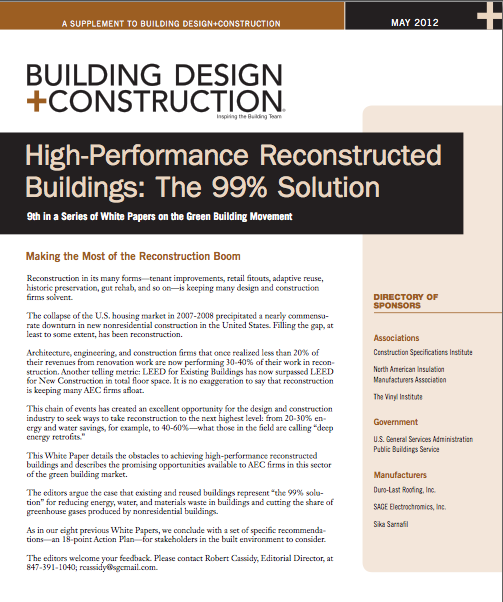Reconstruction in its many forms—tenant improvements, retail fitouts, adaptive reuse, historic preservation, gut rehab, and so on—is keeping many design and construction firms solvent.
The collapse of the U.S. housing market in 2007-2008 precipitated a nearly commensurate downturn in new nonresidential construction in the United States. Filling the gap, at least to some extent, has been reconstruction.
Architecture, engineering, and construction firms that once realized less than 20% of their revenues from renovation work are now performing 30-40% of their work in reconstruction. Another telling metric: LEED for Existing Buildings has now surpassed LEED for New Construction in total floor space. It is no exaggeration to say that reconstruction is keeping many AEC firms afloat.
This chain of events has created an excellent opportunity for the design and construction industry to seek ways to take reconstruction to the next highest level: from 20-30% energy and water savings, for example, to 40-60%—what those in the field are calling “deep energy retrofits.”
This White Paper details the obstacles to achieving high-performance reconstructed buildings and describes the promising opportunities available to AEC firms in this sector of the green building market.
The editors argue the case that existing and reused buildings represent “the 99% solution” for reducing energy, water, and materials waste in buildings and cutting the share of greenhouse gases produced by nonresidential buildings.
As in our eight previous White Papers, we conclude with a set of specific recommendations—an 18-point Action Plan—for stakeholders in the built environment to consider.
The editors welcome your feedback. Please contact Robert Cassidy, Editorial Director, at 847-391-1040; rcassidy@sgcmail.com.
Click here to download a PDF of High-Performance Reconstructed Buildings: The 99% Solution, the 9th in a Series of White Papers on the Green Building Movement
Chapter 1 Reconstruction: ‘The 99% Solution’ for Energy Savings in Buildings
Chapter 2 Exemplary High-Performance Reconstruction Projects
Chapter 3 How Building Technologies Contribute to Reconstruction Advances
Chapter 4 Business Case for High-Performance Reconstructed Buildings
Chapter 5 LEED-EB and Green Globes CIEB: Rating Sustainable Reconstruction
Chapter 6 Energy Codes + Reconstructed Buildings: 2012 and Beyond
Chapter 7 When Modern Becomes Historic: Preserving the Modernist Building Envelope
Chapter 8 High-Performance Reconstruction and Historic Preservation: Conflict and Opportunity
Chapter 9 The Key to Commissioning That Works? It Never Stops
Chapter 10 Action Plan: 18 Recommendations for Advancing Sustainability in Reconstructed Buildings
DIRECTORY OF SPONSORS
Associations
Construction Specifications Institute
North American Insulation Manufacturers Association
The Vinyl Institute
Government
U.S. General Services Administration Public Buildings Service
Manufacturers
Duro-Last Roofing, Inc.
SAGE Electrochromics, Inc.
Sika Sarnafil
Related Stories
| Aug 11, 2010
Billings at U.S. architecture firms exceeds $40 billion annually
In the three-year period leading up to the current recession, gross billings at U.S. architecture firms increased nearly $16 billion from 2005 and totaled $44.3 billion in 2008. This equates to 54 percent growth over the three-year period with annual growth of about 16 percent. These findings are from the American Institute of Architects (AIA) Business of Architecture: AIA Survey Report on Firm Characteristics.
| Aug 11, 2010
CHPS debuts high-performance building products database
The Collaborative for High Performance Schools (CHPS) made a new tool available to product manufacturers to help customers identify building products that contribute to sustainable, healthy, built environments. The tool is an online, searchable database where manufacturers can list products that have met certain environmental or health standards ranging from recycled content to materials that contribute to improved indoor air quality.
| Aug 11, 2010
ICC launches green construction code initiative for commercial buildings
The International Code Council has launched its International Green Construction Code (IGCC) initiative, which will aim to reduce energy usage and the carbon footprint of commercial buildings.Entitled “IGCC: Safe and Sustainable By the Book,” the initiative is committed to develop a model code focused on new and existing commercial buildings. It will focus on building design and performance.
| Aug 11, 2010
Green Building Initiative launches two certification programs for green building professionals
The Green Building Initiative® (GBI), one of the nation’s leading green building organizations and exclusive provider of the Green Globes green building certification in the United States, today announced the availability of two new personnel certification programs for green building practitioners: Green Globes Professional (GGP) and Green Globes Assessor (GGA).
| Aug 11, 2010
Potomac Valley Brick launches brick design competition with $10,000 grand prize
Potomac Valley Brick presents Brick-stainable: Re-Thinking Brick a design competition seeking integrative solutions for a building using clay masonry units (brick) as a primary material.
| Aug 11, 2010
Outdated office tower becomes Nashville’s newest boutique hotel
A 1960s office tower in Nashville, Tenn., has been converted into a 248-room, four-star boutique hotel. Designed by Earl Swensson Associates, with PowerStrip Studio as interior designer, the newly converted Hutton Hotel features 54 suites, two penthouse apartments, 13,600 sf of meeting space, and seven “cardio” rooms.
| Aug 11, 2010
HDR, Perkins+Will top BD+C's ranking of the nation's 100 largest healthcare design firms
A ranking of the Top 100 Healthcare Design Firms based on Building Design+Construction's 2009 Giants 300 survey. For more Giants 300 rankings, visit http://www.BDCnetwork.com/Giants
| Aug 11, 2010
Steel Joist Institute announces 2009 Design Awards
The Steel Joist Institute is now accepting entries for its 2009 Design Awards. The winning entries will be announced in November 2009 and the company with the winning project in each category will be awarded a $2,000 scholarship in its name to a school of its choice for an engineering student.







